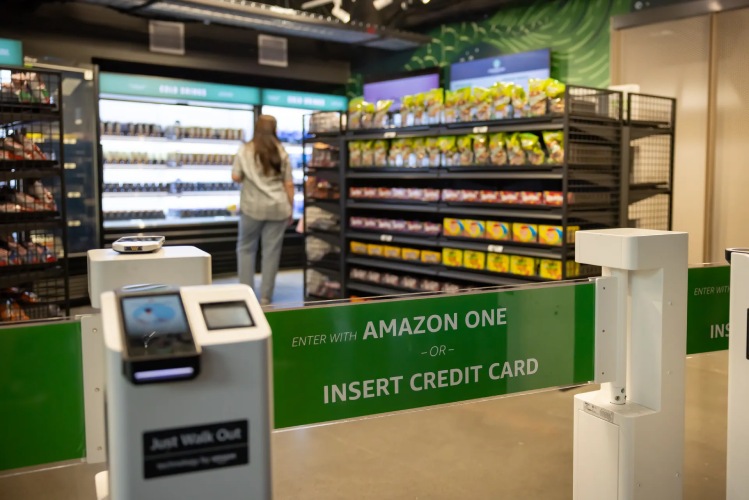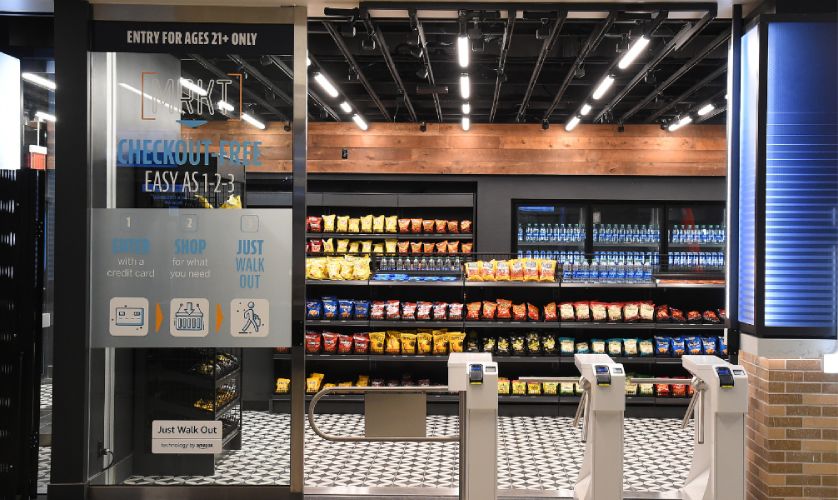Ever considered going inside a store, picking up items you want, and then just walking out? The revolutionary Just Walk Out (JWO) technology, developed by Amazon and used in some stores in the US, UK, and Australia, works exactly like that. With the help of cameras, shelf sensors, deep learning, and generative artificial intelligence (AI), Just Walk Out technology eliminates the need for cashiers and checkout counters. However, considering the significant investment in terms of cost and setup, it may be a while before small businesses can adopt this technology.
Key Takeaways:
- Just Walk Out technology revolutionizes the shopping experience by removing cashiers and checkout counters, allowing customers to simply pick up items and walk out.
- JWO technology tracks items using computer vision, sensor fusion, deep learning, and generative AI as customers browse and select products.
- Amazon has outsourced JWO technology and equipped other establishments with the same tech.
- In April 2024, it was reported that Amazon was phasing out and removing Just Walk Out technology in all of its stores and moving toward Amazon Dash Carts instead. It will retain JWO technology in non-Amazon establishments that are already equipped with it.
What Is Just Walk Out Technology?
Just Walk Out technology (JWO) is a system developed primarily by Amazon that allows customers to enter a store, select and pick up items they wish to purchase, and simply walk out without the need to go through a traditional checkout process. This technology uses a combination of computer vision, sensor fusion, generative AI, and deep learning algorithms to track items as customers take them off the shelves and add them to their virtual shopping cart.
Since our last update: Amazon announced in April 2024 that it is removing and phasing out Just Walk Out technology in all their Amazon Fresh, Amazon Go, and Whole Foods stores. Instead, it is rolling out Amazon Dash Carts, which are smart shopping carts equipped with scanners and screens and still allow cashierless checkouts.
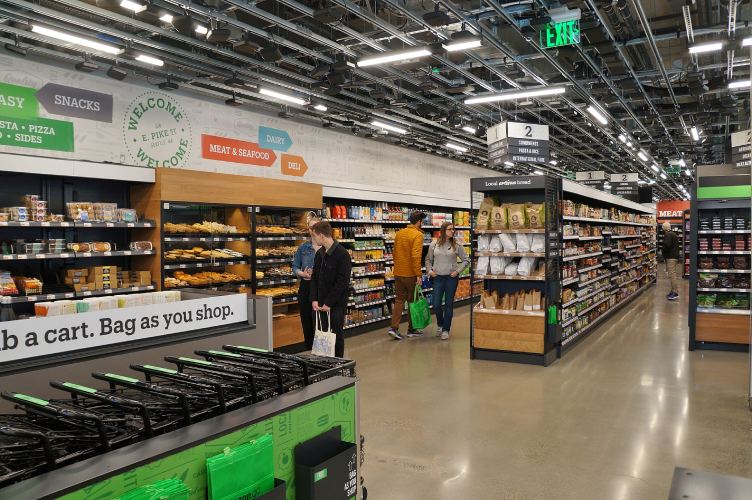
First Amazon Go store with numerous cameras installed on the ceiling. (Source: Wikipedia)
Here’s a breakdown of its key elements:
Computer Vision
Central to Just Walk Out technology is computer vision, which involves the use of cameras and image processing algorithms to track and analyze customer movements and items as they get picked up from and returned to shelves. High-resolution cameras installed throughout the retail space capture real-time footage of customers as they browse and select items.
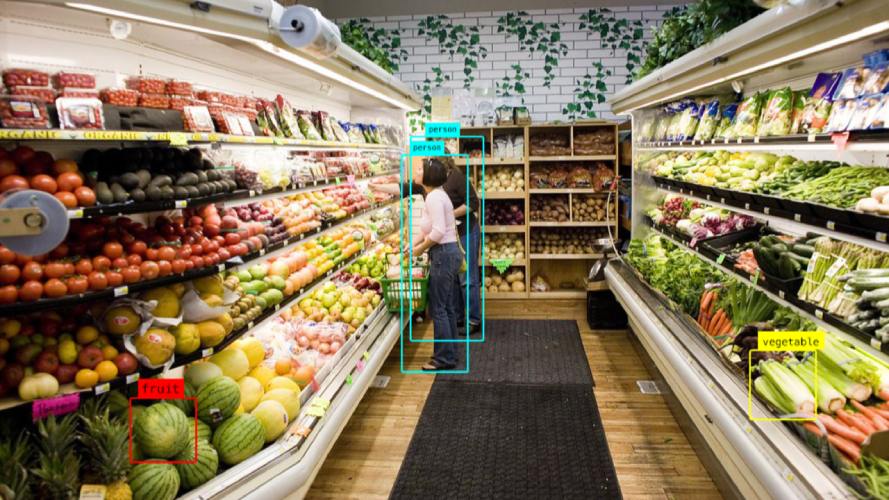
Computer vision being used in a grocery store to track customers and items. (Source: Augmented Startups)
Sensor Fusion
In addition to cameras, Just Walk Out systems often incorporate various sensors, such as weight sensors embedded in shelves or RFID (Radio-Frequency Identification) tags attached to products. These sensors provide additional data points that complement the information gathered through computer vision, enhancing the accuracy of the system.
Deep Learning Algorithms
Behind the scenes, powerful deep learning algorithms process the data collected from cameras and sensors. These algorithms are trained to recognize different objects, gestures, and behaviors, allowing the system to identify when a customer picks up an item, returns it to the shelf, or places it in their shopping basket.
Generative AI
Some Just Walk Out systems utilize generative AI models to enhance the accuracy and efficiency of item tracking. Generative AI can generate realistic images and scenarios based on learned patterns to help further train the system to better interpret and analyze complex shopping behaviors.
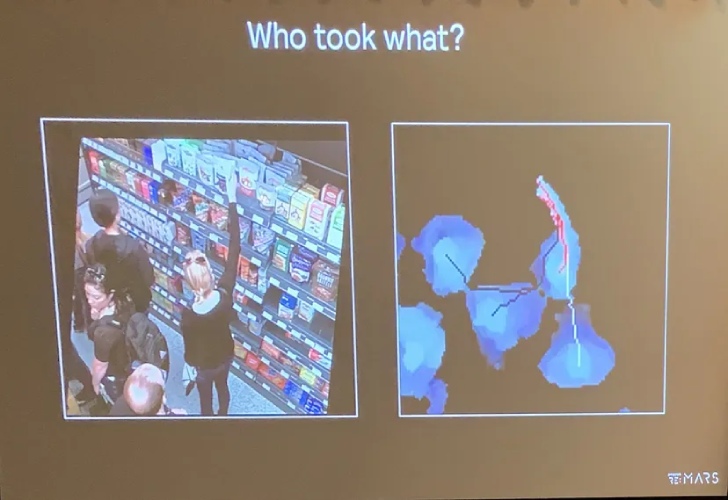
Simulated data at work. (Source: Toward Data Science)
Customer Tracking
Just Walk Out technology employs advanced algorithms to track individual customers as they move throughout the store. By analyzing factors such as gait, clothing color, and unique features, the system can distinguish between multiple shoppers and attribute selected items to the appropriate customer’s account.
Virtual Shopping Cart
As customers select items from the shelves, the Just Walk Out system automatically adds these products to their virtual shopping cart. This digital record is continuously updated in real time as customers browse and make their selections.
Digital Payment Processing
Once customers have completed their shopping, they can simply exit the store without the need to go through a traditional checkout process. Just Walk Out technology automatically calculates the total cost of items in the customer’s virtual shopping cart and charges their account using a pre-registered payment method, such as a credit card or mobile payment app.
How Does Just Walk Out Technology Work?
The idea of customers just shopping and walking out seems so simple but is the process really that straightforward? The quick answer is both yes and no. If a customer has everything set up on their end to get them ready to shop, then the technology does provide a quick, easy, and convenient way to shop. If not, then the customer will first need to get everything ready before stepping into a store using JWO technology. Here’s a quick rundown of what a customer’s journey looks like:
Step 1: Entry & Customer Setup
Stores that use a Just Walk Out technology require customers to install an app or have a credit card they need to dip before they start shopping. For Amazon Go stores, there are three ways to enter the store:
- Using the Amazon Shopping app
- Install the Amazon Shopping app
- Add a payment method
- Open the app and look for the in-store code under the search bar
- Scan the QR code at the store entrance
- Using a credit card:
- Dip your credit card at the store entrance
- Wait for the check mark before entering the store
- Using Amazon One:
- Place your palm just above the palm scanner
- Wait for the check mark before entering the store
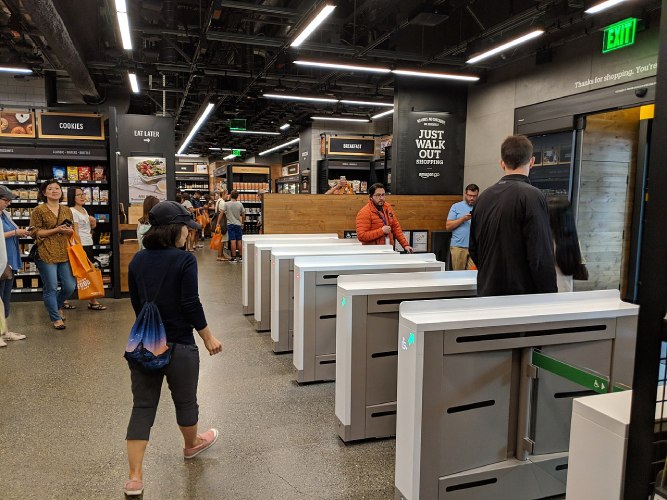
Store entrance at the first Amazon Go store (Source: Wikipedia)
When shopping with other people, a customer just needs to let their companions such as family members or friends enter the store first after using any of the entry methods. This will create one virtual cart for all the members of the group.
Step 2: Start Shopping
The premise is that JWO stores let customers shop as usual, so customers may browse and pick up items as they usually would when shopping. Items that the customer picks up from the shelves will be automatically added to their virtual shopping cart. If the customer changes their mind and wants to return some items, they can just put the items back on the shelf and the system will remove the item from their shopping cart.
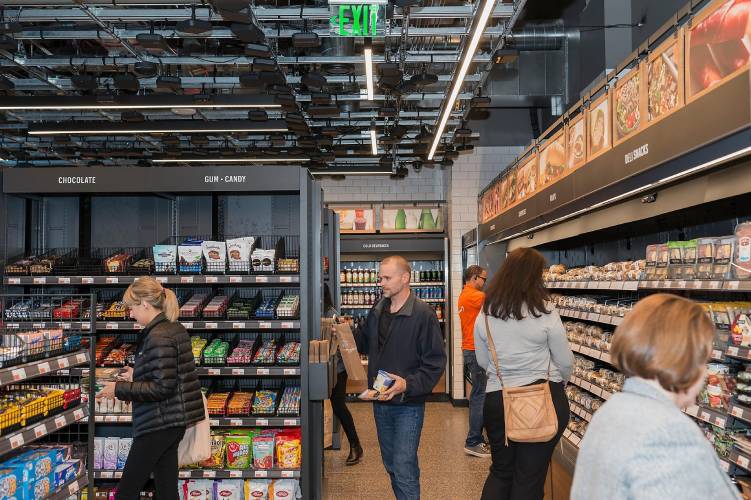
Customers shop at an Amazon Go in Seattle with overhead cameras to track customer movements and items. (Source: San Francisco Chronicle)
For people shopping as a group, all the items picked up by members of the group will be added to the group’s virtual cart.
Step 3: Just Walk Out
Upon completing their shopping, customers can simply exit the store without the need to wait in line or go through a traditional checkout process. The payment process is automated and seamless—the total cost in the customer’s virtual shopping cart is calculated and charged to their Amazon account or the credit card dipped at the store entrance. This streamlined checkout experience eliminates friction and enhances overall customer satisfaction.
Step 4: Digital Receipt Is Sent
When shopping at Amazon Go, Amazon Fresh, or Whole Foods Market stores with JWO technology, the receipt is made available in the Amazon Shopping app anywhere from a few minutes to a few hours after shopping. Customers may also request refunds for items through the app. For customers who entered the store using a card that’s not stored in an Amazon account, the receipt can be looked up using Amazon’s Receipt Lookup.
Just Walk Out Technology in the Real World
Amazon had a limited launch of the Just Walk Out technology in a store at their Seattle headquarters that was only available for employees Dec. 5, 2016. After a little over a year, it opened to the public Jan. 22, 2018.
As of this writing, Amazon has the most number of stores that use cashierless technology. Just Walk Out is available in 20+ Amazon Go stores, 20+ Amazon Fresh locations, and 2 Whole Foods Markets. This number has been reduced in 2023, but Amazon has started to capitalize on its technology by offering it to other establishments such as convenience stores, groceries, airports, stadiums, and schools. It is currently in use in 16 airports, 24 stadiums and arenas, two convention centers, five convenience stores, and seven schools.
How Just Walk Out Worked Out
Initial reception to Amazon’s Just Walk Out technology is mixed. The opening of its first store to the public was delayed for a year because Amazon needed time to smooth out some issues.
Public Reception
There was considerable interest when Amazon launched JWO technology. People were amazed that they could just shop and walk out without interacting with anyone. Shoppers were curious about how it works and liked that it made shopping fast and easy. The convenience was particularly useful for airport and stadium retailers where people are eager to spend as little time as possible inside the stores.
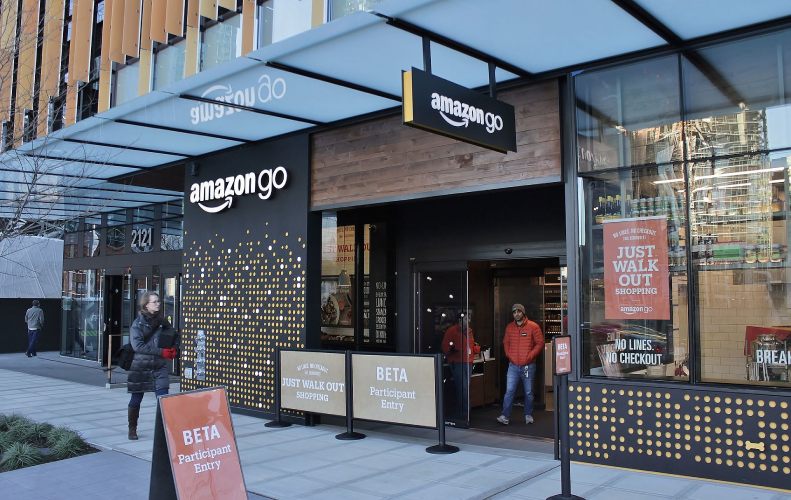
The first Amazon Go store in Seattle was opened in December 2016 to Amazon employees. (Source: Wikipedia)
Business Experience
After more than two years of only using the JWO technology in Amazon Go stores, Amazon started offering its JWO technology to other merchants in March 2020. The service includes providing and powering the cashierless systems, installing all hardware such as ceiling cameras and shelf weight sensors, and 24/7 technical support.
It’s been successful in sports venues such as the Climate Pledge Arena, Texas A&M, and TD Garden as it allows customers to purchase items, get back to their seats quickly, and not miss a lot of game action.
Closure of Amazon Go Stores
In 2023, Amazon permanently closed eight of its stores to cut costs and to focus on a leaner company. Despite closing several stores, Amazon continues to push its Just Walk Out technology to other businesses and retailers.
Just Walk Out Technology Options
Although Amazon is the first to come up with the Just Walk Out technology, there are other companies now that offer technology similar to this concept. If you are a business owner considering adopting this technology in your establishment, here are some options:
Benefits of Just Walk Out Technology
Just Walk Out technology represents a significant leap forward in retail operations, offering numerous advantages to both retailers and customers. Here are some of the key benefits:
- Quick and Frictionless: This technology eliminates the need for traditional checkout processes, allowing customers to simply grab what they need and leave. The absence of checkout lines significantly reduces waiting times, streamlining the shopping experience and enabling a truly grab-and-go environment.
- Data-driven Insights: Retailers gain access to a wealth of data, including key metrics like which products are popular, how customers navigate the store, and peak shopping times. These insights can inform marketing strategies, store layout optimizations, and inventory decisions, ultimately leading to a more efficient and tailored shopping experience.
- Better Inventory Management: Just Walk Out technology offers real-time inventory tracking, reducing the likelihood of stockouts and overstocking. With precise data on how items move off the shelves, retailers can optimize their inventory levels, ensuring that popular products are always available while minimizing waste.
- Improved Customer Experience: By removing the most common pain points associated with in-store shopping, such as waiting in line and the checkout process, customers enjoy a more pleasant shopping experience. This convenience factor can boost customer satisfaction and loyalty, encouraging repeat visits.
- Reduced Labor Costs: Automating the checkout process can lead to significant savings in labor costs. Staff members who would have been stationed at checkout counters can instead be deployed to roles that improve customer service, such as assisting customers on the shop floor or enhancing store security.
Issues & Concerns
While Just Walk Out technology offers numerous benefits, its implementation also raises certain issues and concerns that need to be addressed:
- Technical Challenges: Just Walk Out technology relies heavily on advanced hardware and software components, making it susceptible to technical issues such as system outages, software bugs, or hardware failures. Retailers must have contingency plans in place to address these challenges and minimize disruptions to the shopping experience.
- Costs: For small businesses, implementing this technology in their establishments can be costly as it requires investments in hardware, software, and infrastructure. The upfront expenses and ongoing maintenance costs may pose significant financial challenges for smaller retailers.
- Privacy Concerns: Collecting and analyzing customer data, including their movements and purchasing habits, raises privacy concerns. Customers may be apprehensive about the extent to which their personal information is being tracked and utilized.
- Accuracy and Reliability: The technology relies on sophisticated algorithms to track items and attribute them to the correct customer accounts accurately. Any inaccuracies or glitches in the system could lead to overcharging, undercharging, or other errors, potentially undermining customer trust. These errors and inaccuracies could lead to higher chargebacks.
- Security Risks: Storing sensitive biometric data, such as palm prints or facial recognition data, raises concerns about security breaches and identity theft. Retailers must implement robust security measures to protect this data from unauthorized access or misuse.
- Accessibility Issues: Not all customers may be comfortable or able to use cashless or biometric payment methods. Ensuring that alternative payment options are available for those who prefer or require them is essential for inclusivity.
- Employee Displacement: The automation of checkout processes may lead to concerns about job displacement among retail workers. While Just Walk Out technology can reduce the need for traditional checkout staff, it also creates opportunities for employees to take on more value-added roles within the store.
Frequently Asked Questions (FAQs)
Click through the sections below to learn more about common questions about Just Walk Out technology:
Amazon Fresh tracks the items customers purchase through a combination of digital shopping carts, computer vision, and machine learning algorithms. Customers add items to their cart using the Amazon Fresh app or by scanning them in-store, while cameras and sensors track their movements and interactions. Machine learning algorithms then analyze this data to identify items and associate them with the customer’s account, enabling a seamless checkout process.
The cost of implementing Amazon’s Just Walk Out technology varies depending on factors such as the size of the store, the level of customization required, and additional features desired. While Amazon hasn’t disclosed specific pricing details publicly, it typically involves upfront investments in hardware, software, and infrastructure, along with ongoing maintenance expenses. Community Groceries in Kansas City was reportedly quoted by Amazon $240,000 per store to equip it with JWO technology.
Upon returning an item, customers can initiate the process through the Amazon app or website, indicating the reason for the return. Once verified, the refunded amount is credited back to the customer’s account, typically within a few business days. If the item was mistakenly charged due to a technical error, customers can contact Amazon customer service for assistance in resolving the issue promptly.
Bottom Line
Just Walk Out technology revolutionizes retail by offering cashierless shopping experiences, enhancing convenience, and optimizing inventory management. While initially pioneered by Amazon, other retailers and companies are adopting similar technologies, leveraging advanced systems like computer vision and AI to transform the way customers shop.
Small businesses can benefit from JWO technology by reducing labor costs, improving efficiency, enhancing the customer experience, providing access to valuable data insights, and offering a competitive edge in the market. However, using JWO and other similar cashierless technologies can be costly, and small businesses should carefully consider the investment cost along with potential risks.
